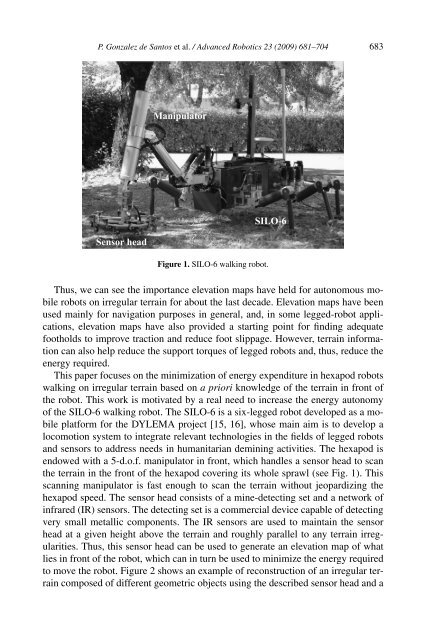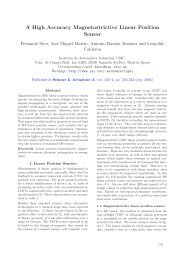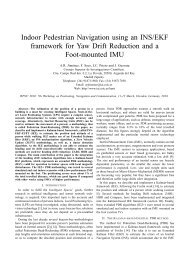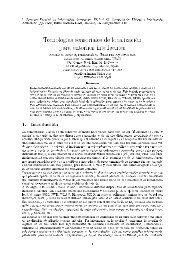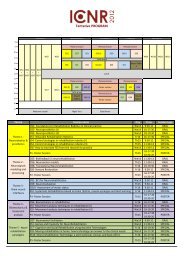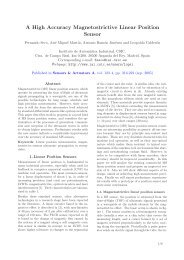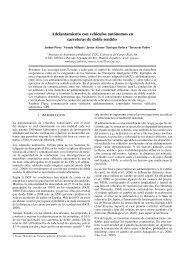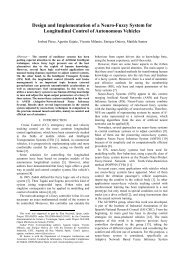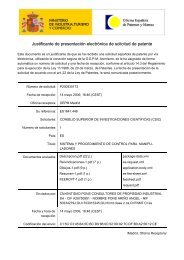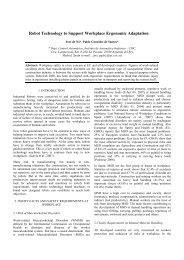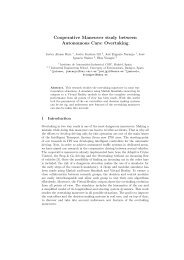Full paper Minimizing Energy Consumption in Hexapod Robots
Full paper Minimizing Energy Consumption in Hexapod Robots
Full paper Minimizing Energy Consumption in Hexapod Robots
You also want an ePaper? Increase the reach of your titles
YUMPU automatically turns print PDFs into web optimized ePapers that Google loves.
P. Gonzalez de Santos et al. / Advanced Robotics 23 (2009) 681–704 683Figure 1. SILO-6 walk<strong>in</strong>g robot.Thus, we can see the importance elevation maps have held for autonomous mobilerobots on irregular terra<strong>in</strong> for about the last decade. Elevation maps have beenused ma<strong>in</strong>ly for navigation purposes <strong>in</strong> general, and, <strong>in</strong> some legged-robot applications,elevation maps have also provided a start<strong>in</strong>g po<strong>in</strong>t for f<strong>in</strong>d<strong>in</strong>g adequatefootholds to improve traction and reduce foot slippage. However, terra<strong>in</strong> <strong>in</strong>formationcan also help reduce the support torques of legged robots and, thus, reduce theenergy required.This <strong>paper</strong> focuses on the m<strong>in</strong>imization of energy expenditure <strong>in</strong> hexapod robotswalk<strong>in</strong>g on irregular terra<strong>in</strong> based on aprioriknowledge of the terra<strong>in</strong> <strong>in</strong> front ofthe robot. This work is motivated by a real need to <strong>in</strong>crease the energy autonomyof the SILO-6 walk<strong>in</strong>g robot. The SILO-6 is a six-legged robot developed as a mobileplatform for the DYLEMA project [15, 16], whose ma<strong>in</strong> aim is to develop alocomotion system to <strong>in</strong>tegrate relevant technologies <strong>in</strong> the fields of legged robotsand sensors to address needs <strong>in</strong> humanitarian dem<strong>in</strong><strong>in</strong>g activities. The hexapod isendowed with a 5-d.o.f. manipulator <strong>in</strong> front, which handles a sensor head to scanthe terra<strong>in</strong> <strong>in</strong> the front of the hexapod cover<strong>in</strong>g its whole sprawl (see Fig. 1). Thisscann<strong>in</strong>g manipulator is fast enough to scan the terra<strong>in</strong> without jeopardiz<strong>in</strong>g thehexapod speed. The sensor head consists of a m<strong>in</strong>e-detect<strong>in</strong>g set and a network of<strong>in</strong>frared (IR) sensors. The detect<strong>in</strong>g set is a commercial device capable of detect<strong>in</strong>gvery small metallic components. The IR sensors are used to ma<strong>in</strong>ta<strong>in</strong> the sensorhead at a given height above the terra<strong>in</strong> and roughly parallel to any terra<strong>in</strong> irregularities.Thus, this sensor head can be used to generate an elevation map of whatlies <strong>in</strong> front of the robot, which can <strong>in</strong> turn be used to m<strong>in</strong>imize the energy requiredto move the robot. Figure 2 shows an example of reconstruction of an irregular terra<strong>in</strong>composed of different geometric objects us<strong>in</strong>g the described sensor head and a


